Managing Communication, Information and Technology at ASDA Report
VerifiedAdded on 2020/02/05
|16
|4742
|1282
Report
AI Summary
This report provides a comprehensive analysis of ASDA's management practices, focusing on the critical roles of communication, information, and technology in its decision-making processes. The report begins by outlining the range of decisions made by ASDA's management, encompassing strategic, tactical, and operational levels, and details the information and knowledge essential for informed choices. It then assesses the various internal and external sources of information available to ASDA, including government data, trade groupings, commercial reports, financial data, and marketing insights. The report also examines ASDA's stakeholder involvement in the decision-making process, highlighting the strategies employed to engage stakeholders and incorporate their perspectives. Finally, it concludes with recommendations for improving ASDA's decision-making processes, emphasizing the importance of updated information, modern communication approaches, and stakeholder collaboration to enhance the effectiveness of its management strategies. The report uses ASDA as a case study and draws on secondary sources to support its findings.
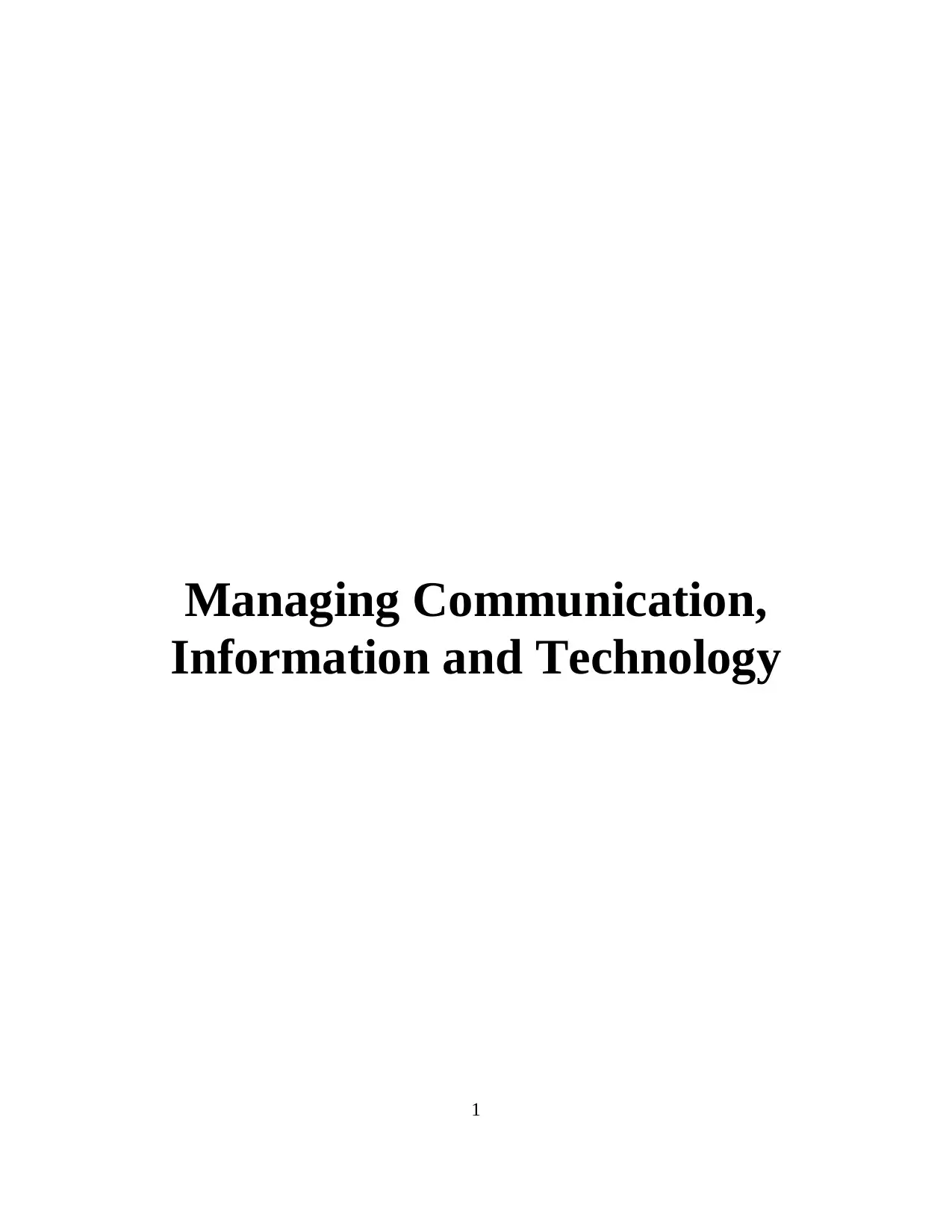
Managing Communication,
Information and Technology
1
Information and Technology
1
Paraphrase This Document
Need a fresh take? Get an instant paraphrase of this document with our AI Paraphraser
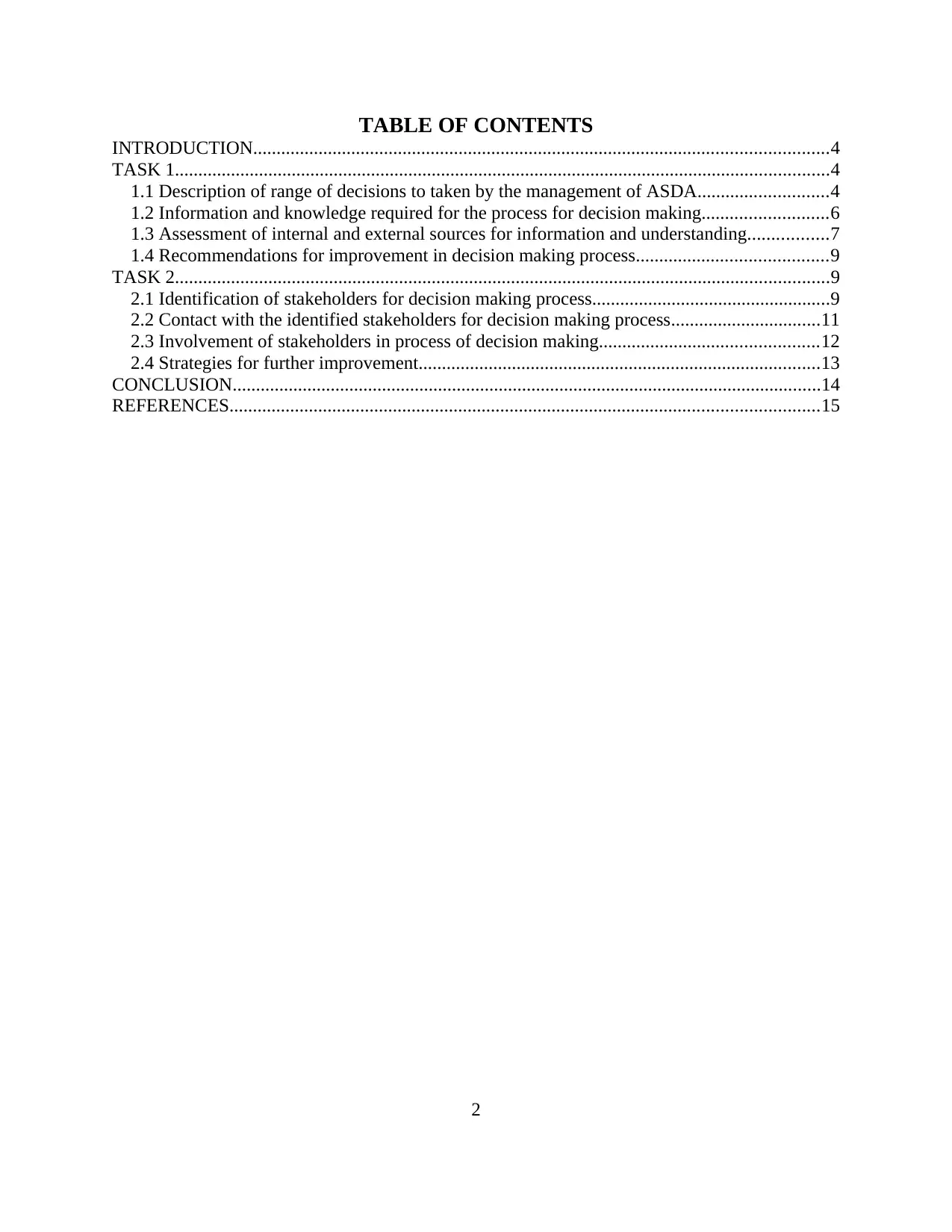
TABLE OF CONTENTS
INTRODUCTION...........................................................................................................................4
TASK 1............................................................................................................................................4
1.1 Description of range of decisions to taken by the management of ASDA............................4
1.2 Information and knowledge required for the process for decision making...........................6
1.3 Assessment of internal and external sources for information and understanding.................7
1.4 Recommendations for improvement in decision making process.........................................9
TASK 2............................................................................................................................................9
2.1 Identification of stakeholders for decision making process...................................................9
2.2 Contact with the identified stakeholders for decision making process................................11
2.3 Involvement of stakeholders in process of decision making...............................................12
2.4 Strategies for further improvement......................................................................................13
CONCLUSION..............................................................................................................................14
REFERENCES..............................................................................................................................15
2
INTRODUCTION...........................................................................................................................4
TASK 1............................................................................................................................................4
1.1 Description of range of decisions to taken by the management of ASDA............................4
1.2 Information and knowledge required for the process for decision making...........................6
1.3 Assessment of internal and external sources for information and understanding.................7
1.4 Recommendations for improvement in decision making process.........................................9
TASK 2............................................................................................................................................9
2.1 Identification of stakeholders for decision making process...................................................9
2.2 Contact with the identified stakeholders for decision making process................................11
2.3 Involvement of stakeholders in process of decision making...............................................12
2.4 Strategies for further improvement......................................................................................13
CONCLUSION..............................................................................................................................14
REFERENCES..............................................................................................................................15
2
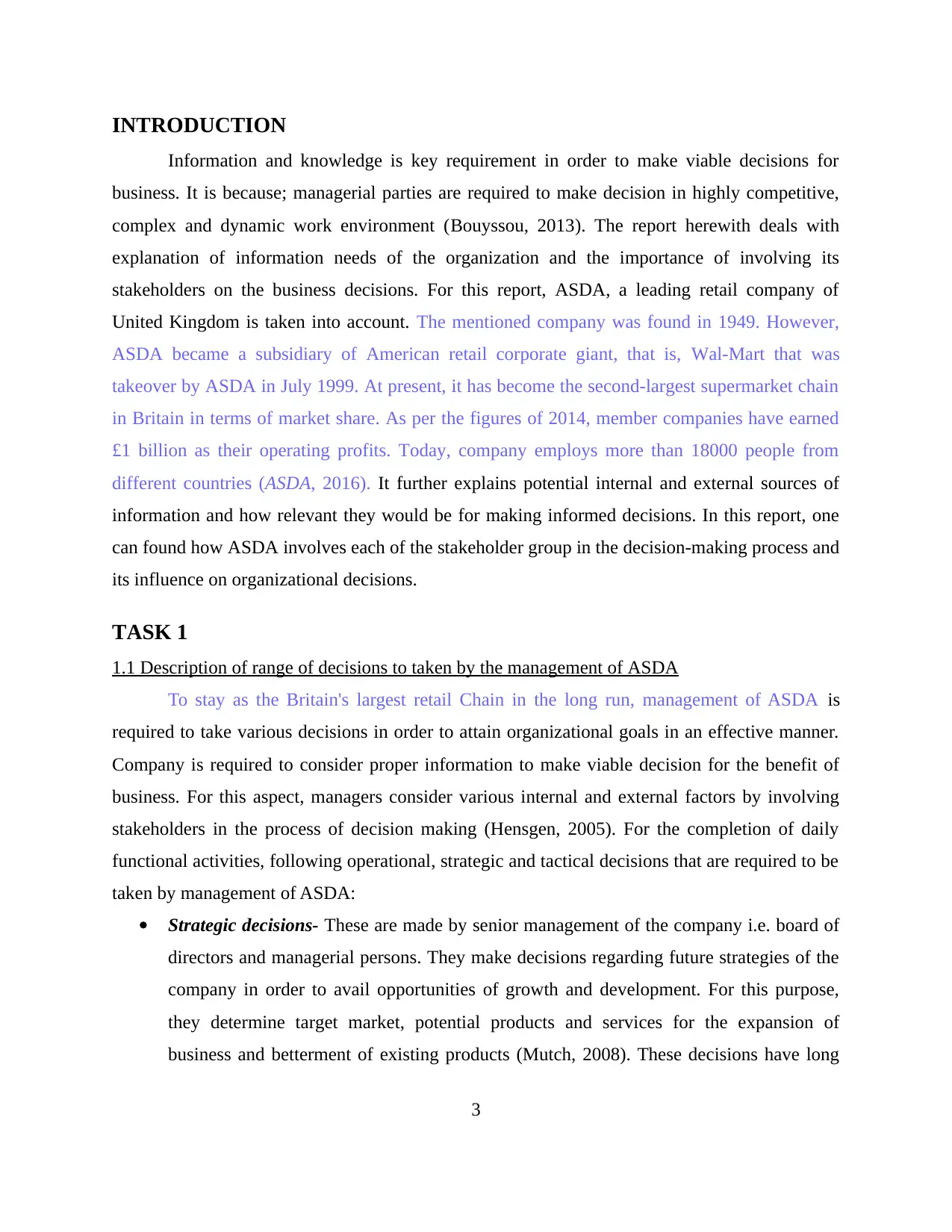
INTRODUCTION
Information and knowledge is key requirement in order to make viable decisions for
business. It is because; managerial parties are required to make decision in highly competitive,
complex and dynamic work environment (Bouyssou, 2013). The report herewith deals with
explanation of information needs of the organization and the importance of involving its
stakeholders on the business decisions. For this report, ASDA, a leading retail company of
United Kingdom is taken into account. The mentioned company was found in 1949. However,
ASDA became a subsidiary of American retail corporate giant, that is, Wal-Mart that was
takeover by ASDA in July 1999. At present, it has become the second-largest supermarket chain
in Britain in terms of market share. As per the figures of 2014, member companies have earned
£1 billion as their operating profits. Today, company employs more than 18000 people from
different countries (ASDA, 2016). It further explains potential internal and external sources of
information and how relevant they would be for making informed decisions. In this report, one
can found how ASDA involves each of the stakeholder group in the decision-making process and
its influence on organizational decisions.
TASK 1
1.1 Description of range of decisions to taken by the management of ASDA
To stay as the Britain's largest retail Chain in the long run, management of ASDA is
required to take various decisions in order to attain organizational goals in an effective manner.
Company is required to consider proper information to make viable decision for the benefit of
business. For this aspect, managers consider various internal and external factors by involving
stakeholders in the process of decision making (Hensgen, 2005). For the completion of daily
functional activities, following operational, strategic and tactical decisions that are required to be
taken by management of ASDA:
Strategic decisions- These are made by senior management of the company i.e. board of
directors and managerial persons. They make decisions regarding future strategies of the
company in order to avail opportunities of growth and development. For this purpose,
they determine target market, potential products and services for the expansion of
business and betterment of existing products (Mutch, 2008). These decisions have long
3
Information and knowledge is key requirement in order to make viable decisions for
business. It is because; managerial parties are required to make decision in highly competitive,
complex and dynamic work environment (Bouyssou, 2013). The report herewith deals with
explanation of information needs of the organization and the importance of involving its
stakeholders on the business decisions. For this report, ASDA, a leading retail company of
United Kingdom is taken into account. The mentioned company was found in 1949. However,
ASDA became a subsidiary of American retail corporate giant, that is, Wal-Mart that was
takeover by ASDA in July 1999. At present, it has become the second-largest supermarket chain
in Britain in terms of market share. As per the figures of 2014, member companies have earned
£1 billion as their operating profits. Today, company employs more than 18000 people from
different countries (ASDA, 2016). It further explains potential internal and external sources of
information and how relevant they would be for making informed decisions. In this report, one
can found how ASDA involves each of the stakeholder group in the decision-making process and
its influence on organizational decisions.
TASK 1
1.1 Description of range of decisions to taken by the management of ASDA
To stay as the Britain's largest retail Chain in the long run, management of ASDA is
required to take various decisions in order to attain organizational goals in an effective manner.
Company is required to consider proper information to make viable decision for the benefit of
business. For this aspect, managers consider various internal and external factors by involving
stakeholders in the process of decision making (Hensgen, 2005). For the completion of daily
functional activities, following operational, strategic and tactical decisions that are required to be
taken by management of ASDA:
Strategic decisions- These are made by senior management of the company i.e. board of
directors and managerial persons. They make decisions regarding future strategies of the
company in order to avail opportunities of growth and development. For this purpose,
they determine target market, potential products and services for the expansion of
business and betterment of existing products (Mutch, 2008). These decisions have long
3
⊘ This is a preview!⊘
Do you want full access?
Subscribe today to unlock all pages.

Trusted by 1+ million students worldwide
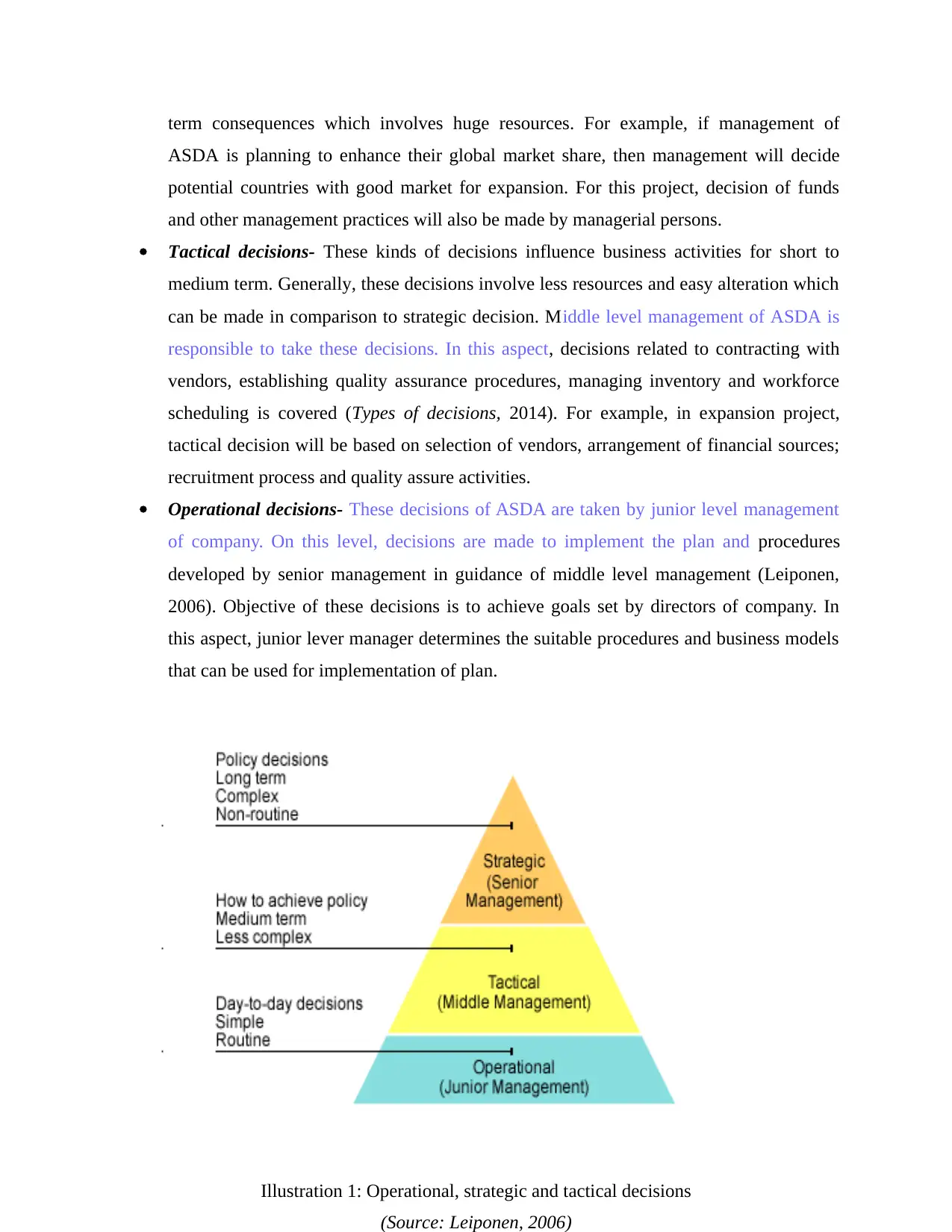
term consequences which involves huge resources. For example, if management of
ASDA is planning to enhance their global market share, then management will decide
potential countries with good market for expansion. For this project, decision of funds
and other management practices will also be made by managerial persons.
Tactical decisions- These kinds of decisions influence business activities for short to
medium term. Generally, these decisions involve less resources and easy alteration which
can be made in comparison to strategic decision. Middle level management of ASDA is
responsible to take these decisions. In this aspect, decisions related to contracting with
vendors, establishing quality assurance procedures, managing inventory and workforce
scheduling is covered (Types of decisions, 2014). For example, in expansion project,
tactical decision will be based on selection of vendors, arrangement of financial sources;
recruitment process and quality assure activities.
Operational decisions- These decisions of ASDA are taken by junior level management
of company. On this level, decisions are made to implement the plan and procedures
developed by senior management in guidance of middle level management (Leiponen,
2006). Objective of these decisions is to achieve goals set by directors of company. In
this aspect, junior lever manager determines the suitable procedures and business models
that can be used for implementation of plan.
4
Illustration 1: Operational, strategic and tactical decisions
(Source: Leiponen, 2006)
ASDA is planning to enhance their global market share, then management will decide
potential countries with good market for expansion. For this project, decision of funds
and other management practices will also be made by managerial persons.
Tactical decisions- These kinds of decisions influence business activities for short to
medium term. Generally, these decisions involve less resources and easy alteration which
can be made in comparison to strategic decision. Middle level management of ASDA is
responsible to take these decisions. In this aspect, decisions related to contracting with
vendors, establishing quality assurance procedures, managing inventory and workforce
scheduling is covered (Types of decisions, 2014). For example, in expansion project,
tactical decision will be based on selection of vendors, arrangement of financial sources;
recruitment process and quality assure activities.
Operational decisions- These decisions of ASDA are taken by junior level management
of company. On this level, decisions are made to implement the plan and procedures
developed by senior management in guidance of middle level management (Leiponen,
2006). Objective of these decisions is to achieve goals set by directors of company. In
this aspect, junior lever manager determines the suitable procedures and business models
that can be used for implementation of plan.
4
Illustration 1: Operational, strategic and tactical decisions
(Source: Leiponen, 2006)
Paraphrase This Document
Need a fresh take? Get an instant paraphrase of this document with our AI Paraphraser
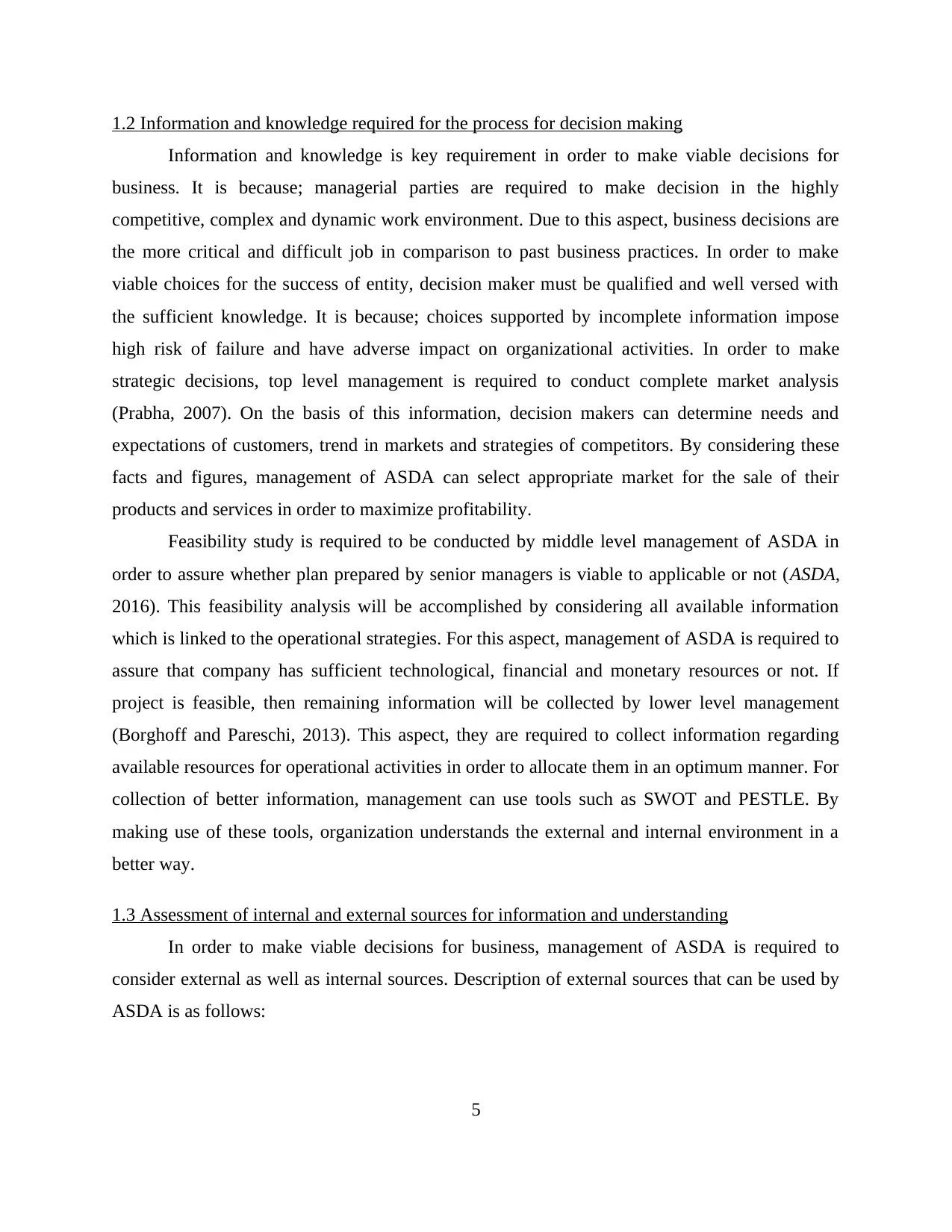
1.2 Information and knowledge required for the process for decision making
Information and knowledge is key requirement in order to make viable decisions for
business. It is because; managerial parties are required to make decision in the highly
competitive, complex and dynamic work environment. Due to this aspect, business decisions are
the more critical and difficult job in comparison to past business practices. In order to make
viable choices for the success of entity, decision maker must be qualified and well versed with
the sufficient knowledge. It is because; choices supported by incomplete information impose
high risk of failure and have adverse impact on organizational activities. In order to make
strategic decisions, top level management is required to conduct complete market analysis
(Prabha, 2007). On the basis of this information, decision makers can determine needs and
expectations of customers, trend in markets and strategies of competitors. By considering these
facts and figures, management of ASDA can select appropriate market for the sale of their
products and services in order to maximize profitability.
Feasibility study is required to be conducted by middle level management of ASDA in
order to assure whether plan prepared by senior managers is viable to applicable or not (ASDA,
2016). This feasibility analysis will be accomplished by considering all available information
which is linked to the operational strategies. For this aspect, management of ASDA is required to
assure that company has sufficient technological, financial and monetary resources or not. If
project is feasible, then remaining information will be collected by lower level management
(Borghoff and Pareschi, 2013). This aspect, they are required to collect information regarding
available resources for operational activities in order to allocate them in an optimum manner. For
collection of better information, management can use tools such as SWOT and PESTLE. By
making use of these tools, organization understands the external and internal environment in a
better way.
1.3 Assessment of internal and external sources for information and understanding
In order to make viable decisions for business, management of ASDA is required to
consider external as well as internal sources. Description of external sources that can be used by
ASDA is as follows:
5
Information and knowledge is key requirement in order to make viable decisions for
business. It is because; managerial parties are required to make decision in the highly
competitive, complex and dynamic work environment. Due to this aspect, business decisions are
the more critical and difficult job in comparison to past business practices. In order to make
viable choices for the success of entity, decision maker must be qualified and well versed with
the sufficient knowledge. It is because; choices supported by incomplete information impose
high risk of failure and have adverse impact on organizational activities. In order to make
strategic decisions, top level management is required to conduct complete market analysis
(Prabha, 2007). On the basis of this information, decision makers can determine needs and
expectations of customers, trend in markets and strategies of competitors. By considering these
facts and figures, management of ASDA can select appropriate market for the sale of their
products and services in order to maximize profitability.
Feasibility study is required to be conducted by middle level management of ASDA in
order to assure whether plan prepared by senior managers is viable to applicable or not (ASDA,
2016). This feasibility analysis will be accomplished by considering all available information
which is linked to the operational strategies. For this aspect, management of ASDA is required to
assure that company has sufficient technological, financial and monetary resources or not. If
project is feasible, then remaining information will be collected by lower level management
(Borghoff and Pareschi, 2013). This aspect, they are required to collect information regarding
available resources for operational activities in order to allocate them in an optimum manner. For
collection of better information, management can use tools such as SWOT and PESTLE. By
making use of these tools, organization understands the external and internal environment in a
better way.
1.3 Assessment of internal and external sources for information and understanding
In order to make viable decisions for business, management of ASDA is required to
consider external as well as internal sources. Description of external sources that can be used by
ASDA is as follows:
5
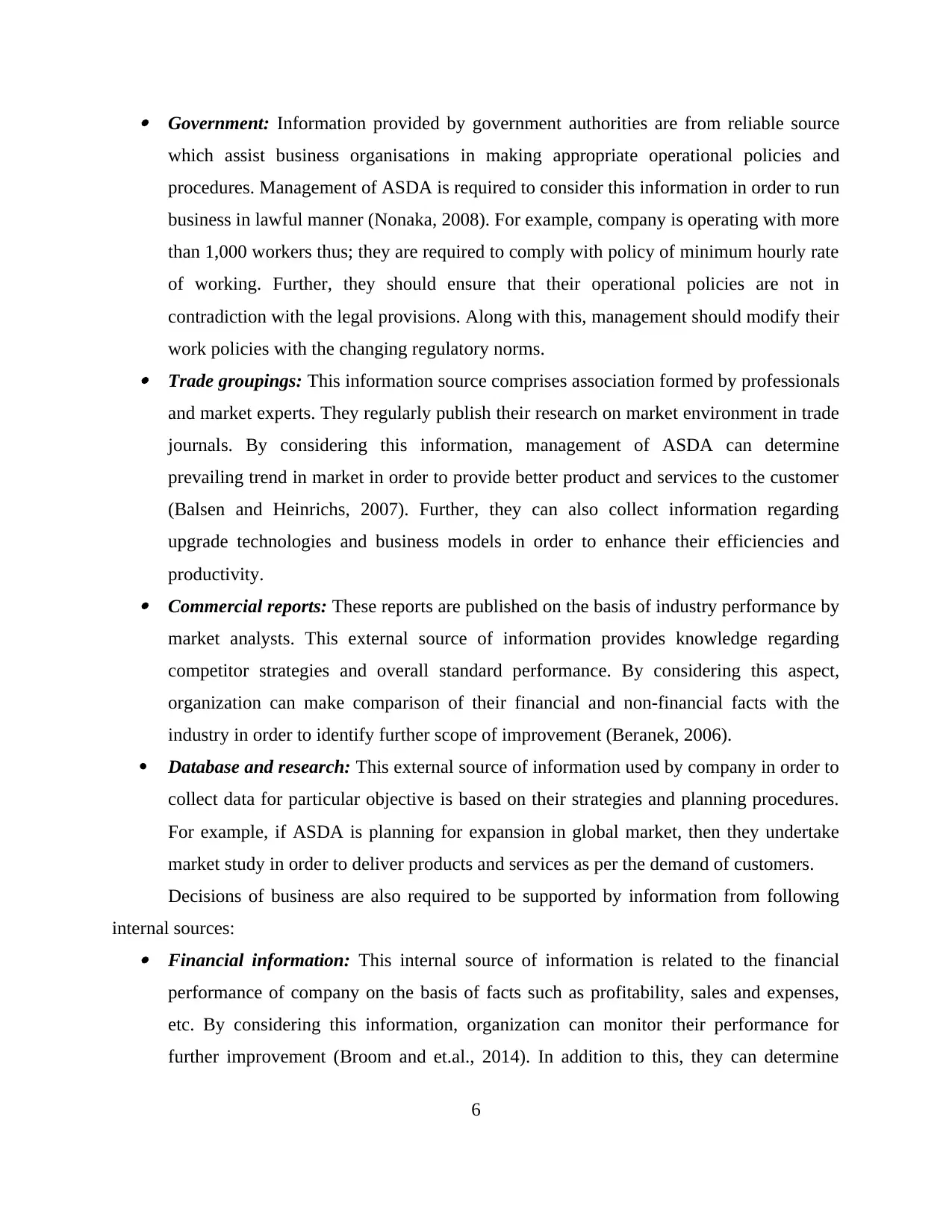
Government: Information provided by government authorities are from reliable source
which assist business organisations in making appropriate operational policies and
procedures. Management of ASDA is required to consider this information in order to run
business in lawful manner (Nonaka, 2008). For example, company is operating with more
than 1,000 workers thus; they are required to comply with policy of minimum hourly rate
of working. Further, they should ensure that their operational policies are not in
contradiction with the legal provisions. Along with this, management should modify their
work policies with the changing regulatory norms. Trade groupings: This information source comprises association formed by professionals
and market experts. They regularly publish their research on market environment in trade
journals. By considering this information, management of ASDA can determine
prevailing trend in market in order to provide better product and services to the customer
(Balsen and Heinrichs, 2007). Further, they can also collect information regarding
upgrade technologies and business models in order to enhance their efficiencies and
productivity. Commercial reports: These reports are published on the basis of industry performance by
market analysts. This external source of information provides knowledge regarding
competitor strategies and overall standard performance. By considering this aspect,
organization can make comparison of their financial and non-financial facts with the
industry in order to identify further scope of improvement (Beranek, 2006).
Database and research: This external source of information used by company in order to
collect data for particular objective is based on their strategies and planning procedures.
For example, if ASDA is planning for expansion in global market, then they undertake
market study in order to deliver products and services as per the demand of customers.
Decisions of business are also required to be supported by information from following
internal sources: Financial information: This internal source of information is related to the financial
performance of company on the basis of facts such as profitability, sales and expenses,
etc. By considering this information, organization can monitor their performance for
further improvement (Broom and et.al., 2014). In addition to this, they can determine
6
which assist business organisations in making appropriate operational policies and
procedures. Management of ASDA is required to consider this information in order to run
business in lawful manner (Nonaka, 2008). For example, company is operating with more
than 1,000 workers thus; they are required to comply with policy of minimum hourly rate
of working. Further, they should ensure that their operational policies are not in
contradiction with the legal provisions. Along with this, management should modify their
work policies with the changing regulatory norms. Trade groupings: This information source comprises association formed by professionals
and market experts. They regularly publish their research on market environment in trade
journals. By considering this information, management of ASDA can determine
prevailing trend in market in order to provide better product and services to the customer
(Balsen and Heinrichs, 2007). Further, they can also collect information regarding
upgrade technologies and business models in order to enhance their efficiencies and
productivity. Commercial reports: These reports are published on the basis of industry performance by
market analysts. This external source of information provides knowledge regarding
competitor strategies and overall standard performance. By considering this aspect,
organization can make comparison of their financial and non-financial facts with the
industry in order to identify further scope of improvement (Beranek, 2006).
Database and research: This external source of information used by company in order to
collect data for particular objective is based on their strategies and planning procedures.
For example, if ASDA is planning for expansion in global market, then they undertake
market study in order to deliver products and services as per the demand of customers.
Decisions of business are also required to be supported by information from following
internal sources: Financial information: This internal source of information is related to the financial
performance of company on the basis of facts such as profitability, sales and expenses,
etc. By considering this information, organization can monitor their performance for
further improvement (Broom and et.al., 2014). In addition to this, they can determine
6
⊘ This is a preview!⊘
Do you want full access?
Subscribe today to unlock all pages.

Trusted by 1+ million students worldwide
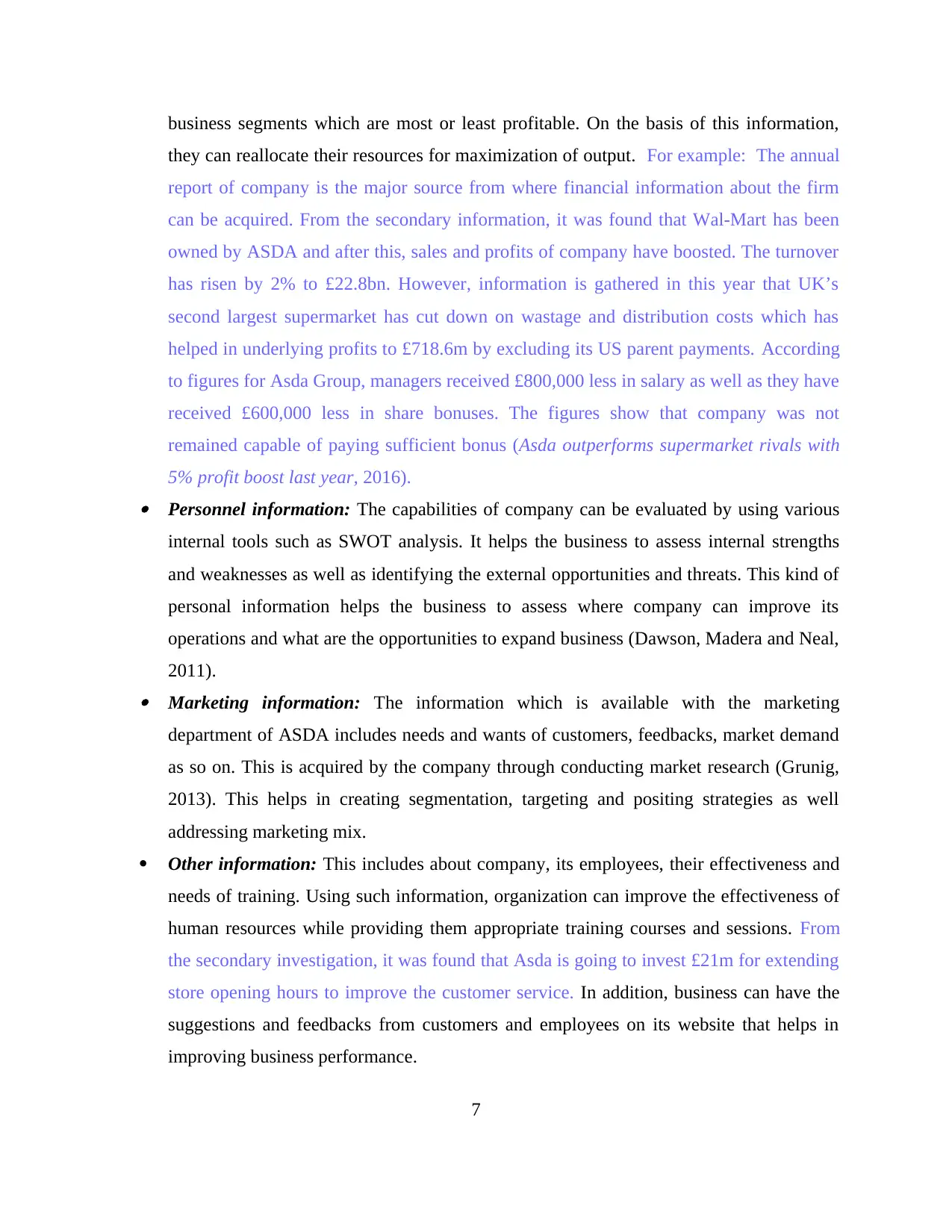
business segments which are most or least profitable. On the basis of this information,
they can reallocate their resources for maximization of output. For example: The annual
report of company is the major source from where financial information about the firm
can be acquired. From the secondary information, it was found that Wal-Mart has been
owned by ASDA and after this, sales and profits of company have boosted. The turnover
has risen by 2% to £22.8bn. However, information is gathered in this year that UK’s
second largest supermarket has cut down on wastage and distribution costs which has
helped in underlying profits to £718.6m by excluding its US parent payments. According
to figures for Asda Group, managers received £800,000 less in salary as well as they have
received £600,000 less in share bonuses. The figures show that company was not
remained capable of paying sufficient bonus (Asda outperforms supermarket rivals with
5% profit boost last year, 2016). Personnel information: The capabilities of company can be evaluated by using various
internal tools such as SWOT analysis. It helps the business to assess internal strengths
and weaknesses as well as identifying the external opportunities and threats. This kind of
personal information helps the business to assess where company can improve its
operations and what are the opportunities to expand business (Dawson, Madera and Neal,
2011). Marketing information: The information which is available with the marketing
department of ASDA includes needs and wants of customers, feedbacks, market demand
as so on. This is acquired by the company through conducting market research (Grunig,
2013). This helps in creating segmentation, targeting and positing strategies as well
addressing marketing mix.
Other information: This includes about company, its employees, their effectiveness and
needs of training. Using such information, organization can improve the effectiveness of
human resources while providing them appropriate training courses and sessions. From
the secondary investigation, it was found that Asda is going to invest £21m for extending
store opening hours to improve the customer service. In addition, business can have the
suggestions and feedbacks from customers and employees on its website that helps in
improving business performance.
7
they can reallocate their resources for maximization of output. For example: The annual
report of company is the major source from where financial information about the firm
can be acquired. From the secondary information, it was found that Wal-Mart has been
owned by ASDA and after this, sales and profits of company have boosted. The turnover
has risen by 2% to £22.8bn. However, information is gathered in this year that UK’s
second largest supermarket has cut down on wastage and distribution costs which has
helped in underlying profits to £718.6m by excluding its US parent payments. According
to figures for Asda Group, managers received £800,000 less in salary as well as they have
received £600,000 less in share bonuses. The figures show that company was not
remained capable of paying sufficient bonus (Asda outperforms supermarket rivals with
5% profit boost last year, 2016). Personnel information: The capabilities of company can be evaluated by using various
internal tools such as SWOT analysis. It helps the business to assess internal strengths
and weaknesses as well as identifying the external opportunities and threats. This kind of
personal information helps the business to assess where company can improve its
operations and what are the opportunities to expand business (Dawson, Madera and Neal,
2011). Marketing information: The information which is available with the marketing
department of ASDA includes needs and wants of customers, feedbacks, market demand
as so on. This is acquired by the company through conducting market research (Grunig,
2013). This helps in creating segmentation, targeting and positing strategies as well
addressing marketing mix.
Other information: This includes about company, its employees, their effectiveness and
needs of training. Using such information, organization can improve the effectiveness of
human resources while providing them appropriate training courses and sessions. From
the secondary investigation, it was found that Asda is going to invest £21m for extending
store opening hours to improve the customer service. In addition, business can have the
suggestions and feedbacks from customers and employees on its website that helps in
improving business performance.
7
Paraphrase This Document
Need a fresh take? Get an instant paraphrase of this document with our AI Paraphraser
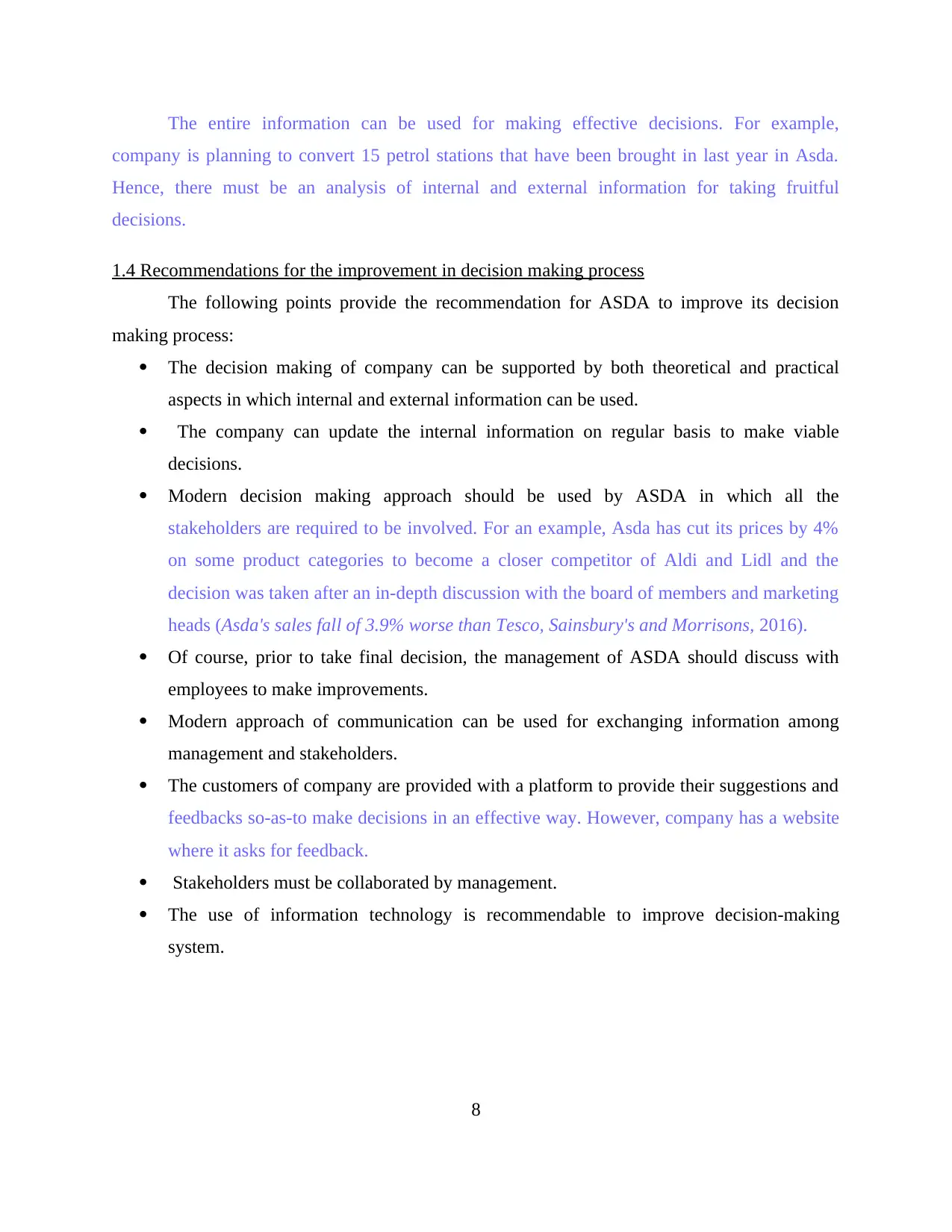
The entire information can be used for making effective decisions. For example,
company is planning to convert 15 petrol stations that have been brought in last year in Asda.
Hence, there must be an analysis of internal and external information for taking fruitful
decisions.
1.4 Recommendations for the improvement in decision making process
The following points provide the recommendation for ASDA to improve its decision
making process:
The decision making of company can be supported by both theoretical and practical
aspects in which internal and external information can be used.
The company can update the internal information on regular basis to make viable
decisions.
Modern decision making approach should be used by ASDA in which all the
stakeholders are required to be involved. For an example, Asda has cut its prices by 4%
on some product categories to become a closer competitor of Aldi and Lidl and the
decision was taken after an in-depth discussion with the board of members and marketing
heads (Asda's sales fall of 3.9% worse than Tesco, Sainsbury's and Morrisons, 2016).
Of course, prior to take final decision, the management of ASDA should discuss with
employees to make improvements.
Modern approach of communication can be used for exchanging information among
management and stakeholders.
The customers of company are provided with a platform to provide their suggestions and
feedbacks so-as-to make decisions in an effective way. However, company has a website
where it asks for feedback.
Stakeholders must be collaborated by management.
The use of information technology is recommendable to improve decision-making
system.
8
company is planning to convert 15 petrol stations that have been brought in last year in Asda.
Hence, there must be an analysis of internal and external information for taking fruitful
decisions.
1.4 Recommendations for the improvement in decision making process
The following points provide the recommendation for ASDA to improve its decision
making process:
The decision making of company can be supported by both theoretical and practical
aspects in which internal and external information can be used.
The company can update the internal information on regular basis to make viable
decisions.
Modern decision making approach should be used by ASDA in which all the
stakeholders are required to be involved. For an example, Asda has cut its prices by 4%
on some product categories to become a closer competitor of Aldi and Lidl and the
decision was taken after an in-depth discussion with the board of members and marketing
heads (Asda's sales fall of 3.9% worse than Tesco, Sainsbury's and Morrisons, 2016).
Of course, prior to take final decision, the management of ASDA should discuss with
employees to make improvements.
Modern approach of communication can be used for exchanging information among
management and stakeholders.
The customers of company are provided with a platform to provide their suggestions and
feedbacks so-as-to make decisions in an effective way. However, company has a website
where it asks for feedback.
Stakeholders must be collaborated by management.
The use of information technology is recommendable to improve decision-making
system.
8
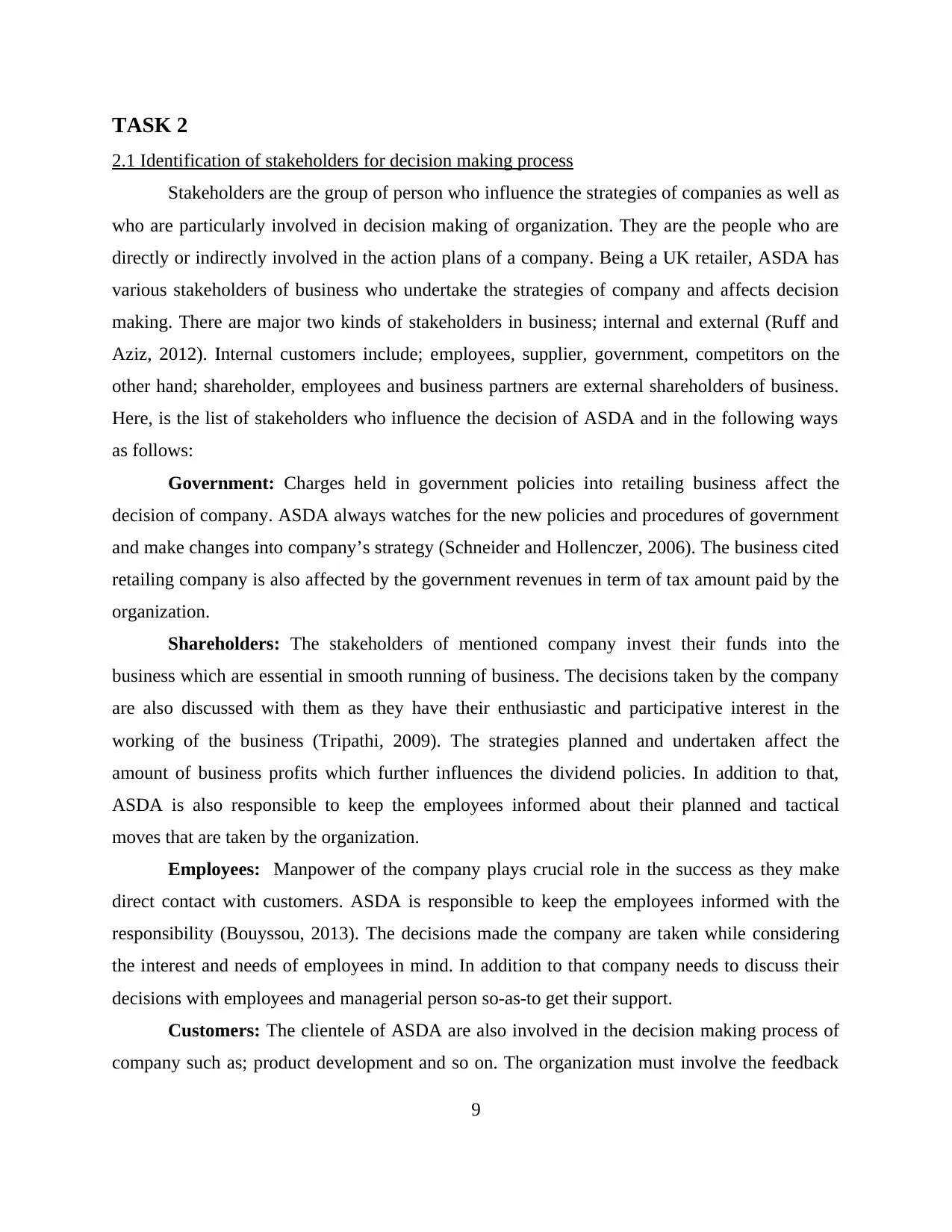
TASK 2
2.1 Identification of stakeholders for decision making process
Stakeholders are the group of person who influence the strategies of companies as well as
who are particularly involved in decision making of organization. They are the people who are
directly or indirectly involved in the action plans of a company. Being a UK retailer, ASDA has
various stakeholders of business who undertake the strategies of company and affects decision
making. There are major two kinds of stakeholders in business; internal and external (Ruff and
Aziz, 2012). Internal customers include; employees, supplier, government, competitors on the
other hand; shareholder, employees and business partners are external shareholders of business.
Here, is the list of stakeholders who influence the decision of ASDA and in the following ways
as follows:
Government: Charges held in government policies into retailing business affect the
decision of company. ASDA always watches for the new policies and procedures of government
and make changes into company’s strategy (Schneider and Hollenczer, 2006). The business cited
retailing company is also affected by the government revenues in term of tax amount paid by the
organization.
Shareholders: The stakeholders of mentioned company invest their funds into the
business which are essential in smooth running of business. The decisions taken by the company
are also discussed with them as they have their enthusiastic and participative interest in the
working of the business (Tripathi, 2009). The strategies planned and undertaken affect the
amount of business profits which further influences the dividend policies. In addition to that,
ASDA is also responsible to keep the employees informed about their planned and tactical
moves that are taken by the organization.
Employees: Manpower of the company plays crucial role in the success as they make
direct contact with customers. ASDA is responsible to keep the employees informed with the
responsibility (Bouyssou, 2013). The decisions made the company are taken while considering
the interest and needs of employees in mind. In addition to that company needs to discuss their
decisions with employees and managerial person so-as-to get their support.
Customers: The clientele of ASDA are also involved in the decision making process of
company such as; product development and so on. The organization must involve the feedback
9
2.1 Identification of stakeholders for decision making process
Stakeholders are the group of person who influence the strategies of companies as well as
who are particularly involved in decision making of organization. They are the people who are
directly or indirectly involved in the action plans of a company. Being a UK retailer, ASDA has
various stakeholders of business who undertake the strategies of company and affects decision
making. There are major two kinds of stakeholders in business; internal and external (Ruff and
Aziz, 2012). Internal customers include; employees, supplier, government, competitors on the
other hand; shareholder, employees and business partners are external shareholders of business.
Here, is the list of stakeholders who influence the decision of ASDA and in the following ways
as follows:
Government: Charges held in government policies into retailing business affect the
decision of company. ASDA always watches for the new policies and procedures of government
and make changes into company’s strategy (Schneider and Hollenczer, 2006). The business cited
retailing company is also affected by the government revenues in term of tax amount paid by the
organization.
Shareholders: The stakeholders of mentioned company invest their funds into the
business which are essential in smooth running of business. The decisions taken by the company
are also discussed with them as they have their enthusiastic and participative interest in the
working of the business (Tripathi, 2009). The strategies planned and undertaken affect the
amount of business profits which further influences the dividend policies. In addition to that,
ASDA is also responsible to keep the employees informed about their planned and tactical
moves that are taken by the organization.
Employees: Manpower of the company plays crucial role in the success as they make
direct contact with customers. ASDA is responsible to keep the employees informed with the
responsibility (Bouyssou, 2013). The decisions made the company are taken while considering
the interest and needs of employees in mind. In addition to that company needs to discuss their
decisions with employees and managerial person so-as-to get their support.
Customers: The clientele of ASDA are also involved in the decision making process of
company such as; product development and so on. The organization must involve the feedback
9
⊘ This is a preview!⊘
Do you want full access?
Subscribe today to unlock all pages.

Trusted by 1+ million students worldwide
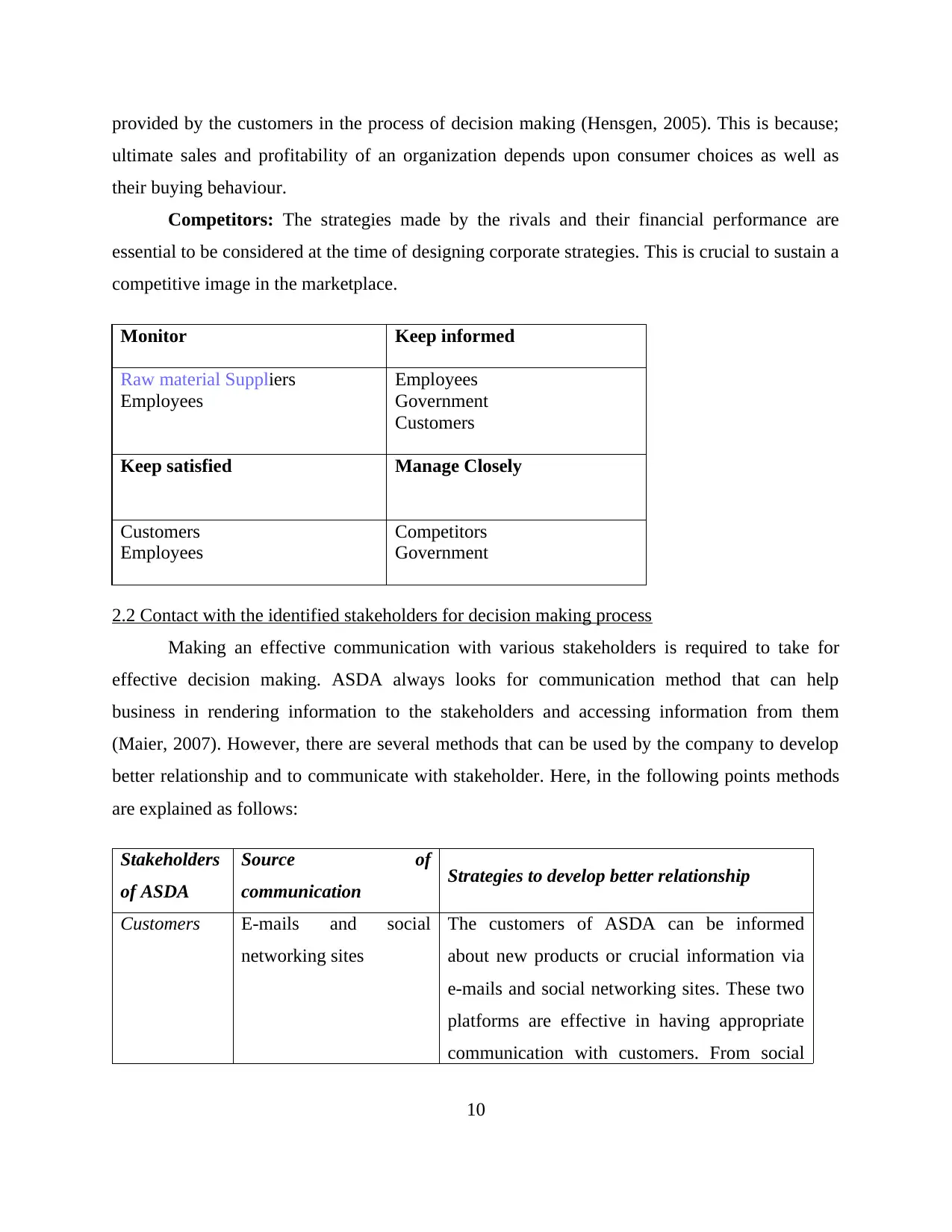
provided by the customers in the process of decision making (Hensgen, 2005). This is because;
ultimate sales and profitability of an organization depends upon consumer choices as well as
their buying behaviour.
Competitors: The strategies made by the rivals and their financial performance are
essential to be considered at the time of designing corporate strategies. This is crucial to sustain a
competitive image in the marketplace.
Monitor Keep informed
Raw material Suppliers
Employees
Employees
Government
Customers
Keep satisfied Manage Closely
Customers
Employees
Competitors
Government
2.2 Contact with the identified stakeholders for decision making process
Making an effective communication with various stakeholders is required to take for
effective decision making. ASDA always looks for communication method that can help
business in rendering information to the stakeholders and accessing information from them
(Maier, 2007). However, there are several methods that can be used by the company to develop
better relationship and to communicate with stakeholder. Here, in the following points methods
are explained as follows:
Stakeholders
of ASDA
Source of
communication Strategies to develop better relationship
Customers E-mails and social
networking sites
The customers of ASDA can be informed
about new products or crucial information via
e-mails and social networking sites. These two
platforms are effective in having appropriate
communication with customers. From social
10
ultimate sales and profitability of an organization depends upon consumer choices as well as
their buying behaviour.
Competitors: The strategies made by the rivals and their financial performance are
essential to be considered at the time of designing corporate strategies. This is crucial to sustain a
competitive image in the marketplace.
Monitor Keep informed
Raw material Suppliers
Employees
Employees
Government
Customers
Keep satisfied Manage Closely
Customers
Employees
Competitors
Government
2.2 Contact with the identified stakeholders for decision making process
Making an effective communication with various stakeholders is required to take for
effective decision making. ASDA always looks for communication method that can help
business in rendering information to the stakeholders and accessing information from them
(Maier, 2007). However, there are several methods that can be used by the company to develop
better relationship and to communicate with stakeholder. Here, in the following points methods
are explained as follows:
Stakeholders
of ASDA
Source of
communication Strategies to develop better relationship
Customers E-mails and social
networking sites
The customers of ASDA can be informed
about new products or crucial information via
e-mails and social networking sites. These two
platforms are effective in having appropriate
communication with customers. From social
10
Paraphrase This Document
Need a fresh take? Get an instant paraphrase of this document with our AI Paraphraser
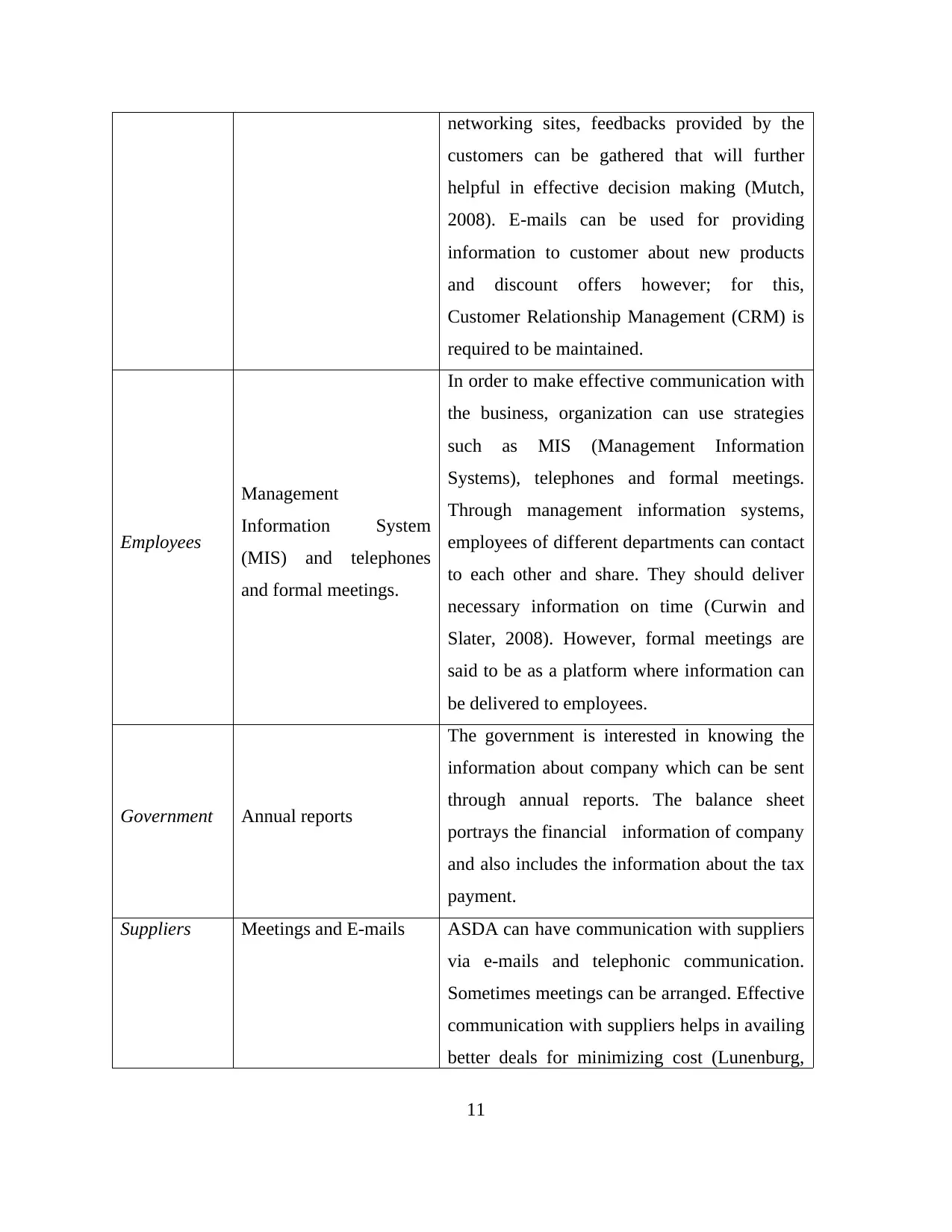
networking sites, feedbacks provided by the
customers can be gathered that will further
helpful in effective decision making (Mutch,
2008). E-mails can be used for providing
information to customer about new products
and discount offers however; for this,
Customer Relationship Management (CRM) is
required to be maintained.
Employees
Management
Information System
(MIS) and telephones
and formal meetings.
In order to make effective communication with
the business, organization can use strategies
such as MIS (Management Information
Systems), telephones and formal meetings.
Through management information systems,
employees of different departments can contact
to each other and share. They should deliver
necessary information on time (Curwin and
Slater, 2008). However, formal meetings are
said to be as a platform where information can
be delivered to employees.
Government Annual reports
The government is interested in knowing the
information about company which can be sent
through annual reports. The balance sheet
portrays the financial information of company
and also includes the information about the tax
payment.
Suppliers Meetings and E-mails ASDA can have communication with suppliers
via e-mails and telephonic communication.
Sometimes meetings can be arranged. Effective
communication with suppliers helps in availing
better deals for minimizing cost (Lunenburg,
11
customers can be gathered that will further
helpful in effective decision making (Mutch,
2008). E-mails can be used for providing
information to customer about new products
and discount offers however; for this,
Customer Relationship Management (CRM) is
required to be maintained.
Employees
Management
Information System
(MIS) and telephones
and formal meetings.
In order to make effective communication with
the business, organization can use strategies
such as MIS (Management Information
Systems), telephones and formal meetings.
Through management information systems,
employees of different departments can contact
to each other and share. They should deliver
necessary information on time (Curwin and
Slater, 2008). However, formal meetings are
said to be as a platform where information can
be delivered to employees.
Government Annual reports
The government is interested in knowing the
information about company which can be sent
through annual reports. The balance sheet
portrays the financial information of company
and also includes the information about the tax
payment.
Suppliers Meetings and E-mails ASDA can have communication with suppliers
via e-mails and telephonic communication.
Sometimes meetings can be arranged. Effective
communication with suppliers helps in availing
better deals for minimizing cost (Lunenburg,
11
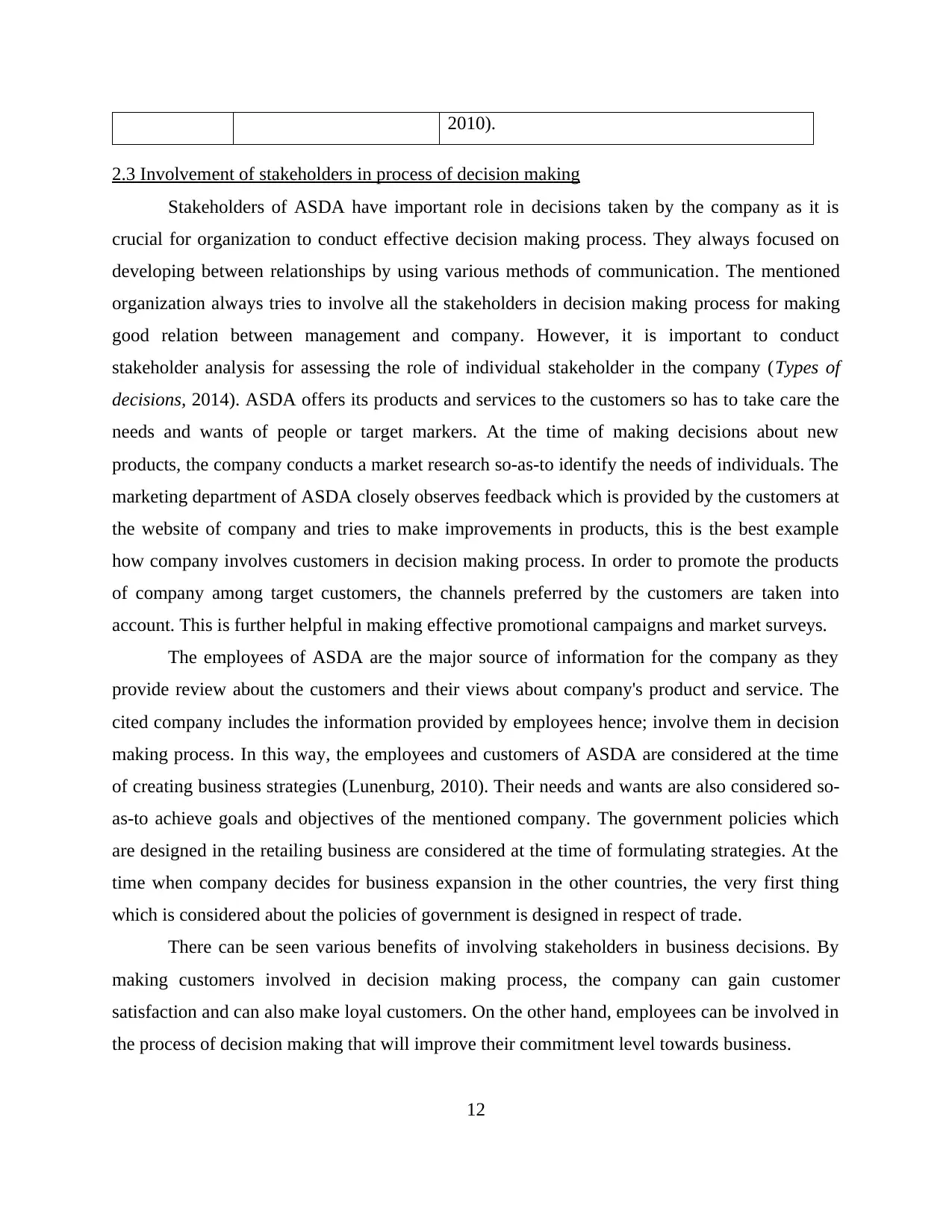
2010).
2.3 Involvement of stakeholders in process of decision making
Stakeholders of ASDA have important role in decisions taken by the company as it is
crucial for organization to conduct effective decision making process. They always focused on
developing between relationships by using various methods of communication. The mentioned
organization always tries to involve all the stakeholders in decision making process for making
good relation between management and company. However, it is important to conduct
stakeholder analysis for assessing the role of individual stakeholder in the company (Types of
decisions, 2014). ASDA offers its products and services to the customers so has to take care the
needs and wants of people or target markers. At the time of making decisions about new
products, the company conducts a market research so-as-to identify the needs of individuals. The
marketing department of ASDA closely observes feedback which is provided by the customers at
the website of company and tries to make improvements in products, this is the best example
how company involves customers in decision making process. In order to promote the products
of company among target customers, the channels preferred by the customers are taken into
account. This is further helpful in making effective promotional campaigns and market surveys.
The employees of ASDA are the major source of information for the company as they
provide review about the customers and their views about company's product and service. The
cited company includes the information provided by employees hence; involve them in decision
making process. In this way, the employees and customers of ASDA are considered at the time
of creating business strategies (Lunenburg, 2010). Their needs and wants are also considered so-
as-to achieve goals and objectives of the mentioned company. The government policies which
are designed in the retailing business are considered at the time of formulating strategies. At the
time when company decides for business expansion in the other countries, the very first thing
which is considered about the policies of government is designed in respect of trade.
There can be seen various benefits of involving stakeholders in business decisions. By
making customers involved in decision making process, the company can gain customer
satisfaction and can also make loyal customers. On the other hand, employees can be involved in
the process of decision making that will improve their commitment level towards business.
12
2.3 Involvement of stakeholders in process of decision making
Stakeholders of ASDA have important role in decisions taken by the company as it is
crucial for organization to conduct effective decision making process. They always focused on
developing between relationships by using various methods of communication. The mentioned
organization always tries to involve all the stakeholders in decision making process for making
good relation between management and company. However, it is important to conduct
stakeholder analysis for assessing the role of individual stakeholder in the company (Types of
decisions, 2014). ASDA offers its products and services to the customers so has to take care the
needs and wants of people or target markers. At the time of making decisions about new
products, the company conducts a market research so-as-to identify the needs of individuals. The
marketing department of ASDA closely observes feedback which is provided by the customers at
the website of company and tries to make improvements in products, this is the best example
how company involves customers in decision making process. In order to promote the products
of company among target customers, the channels preferred by the customers are taken into
account. This is further helpful in making effective promotional campaigns and market surveys.
The employees of ASDA are the major source of information for the company as they
provide review about the customers and their views about company's product and service. The
cited company includes the information provided by employees hence; involve them in decision
making process. In this way, the employees and customers of ASDA are considered at the time
of creating business strategies (Lunenburg, 2010). Their needs and wants are also considered so-
as-to achieve goals and objectives of the mentioned company. The government policies which
are designed in the retailing business are considered at the time of formulating strategies. At the
time when company decides for business expansion in the other countries, the very first thing
which is considered about the policies of government is designed in respect of trade.
There can be seen various benefits of involving stakeholders in business decisions. By
making customers involved in decision making process, the company can gain customer
satisfaction and can also make loyal customers. On the other hand, employees can be involved in
the process of decision making that will improve their commitment level towards business.
12
⊘ This is a preview!⊘
Do you want full access?
Subscribe today to unlock all pages.

Trusted by 1+ million students worldwide
1 out of 16
Related Documents
Your All-in-One AI-Powered Toolkit for Academic Success.
+13062052269
info@desklib.com
Available 24*7 on WhatsApp / Email
![[object Object]](/_next/static/media/star-bottom.7253800d.svg)
Unlock your academic potential
Copyright © 2020–2025 A2Z Services. All Rights Reserved. Developed and managed by ZUCOL.





